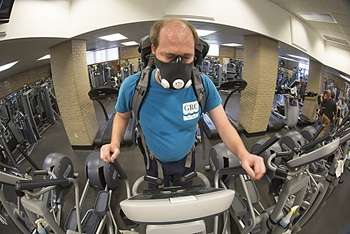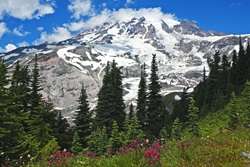Geologist to study life in an ice cave atop Mount Rainier

Ball State University's Lee Florea will soon be part of an exciting generation of research on glaciers—collecting data from inside an ice cave on an episodically active volcano in the state of Washington.
Florea, an assistant professor of geology, will join researchers from New Mexico Tech and Ruhr-University Bochum in Germany, along with a team of experienced cavers at the 14,410-foot-high summit of Mount Rainier. In addition to measuring the impact of global climate change, the team will examine the harsh environment where microbes may thrive and what it might mean for life on other planets.
The Mount Rainier Fumarole Cave Project is set for Aug. 13-22. As part of the project, approved by the National Park Service and sponsored by National Geographic, researchers will explore ice caves on the fifth highest peak in the contiguous United States and the tallest volcano, whose last estimated eruption was between 1820 and 1894.
"I've been invited because of my background in geochemistry as well as my experience in caving," Florea says. "While at Ball State, we've done numerous studies of water in various caves in the Midwest. While the work will be similar, it will be the first time I've been on a mountain summit in an ice cave.
"The Park Service also is seeking as much data about the resources in this park as it can. This labyrinth of caves under the glacier in the crater is one of the places the Park Service has limited data."
Caves formed by rising heat
Florea points out that the mountain's hydro-geothermal system has created the complex system of caves, which form as heat rises from the volcano's depths and melts the base of the ice cap that fills Rainier's twin craters.

"Rainier has been closely studied over several decades, and this will be an expansion of some preliminary work in these ice caves," Florea says. "First, we are going to look at the volume of ice in the crater and how it may have changed in the last few years.
"The mountain has 14 glaciers, and all are melting. So, we need to study the changing volume of the ice just to understand the rate and how this is being impacted by global climate change."
Mount Rainier has about 35 square miles of permanent ice and snow cover. Of all the glaciers in the contiguous U.S., Mount Rainier's Emmons Glacier has the largest surface area (4.3 square miles). Carbon Glacier is the longest (5.7 miles), thickest (700 feet) and deepest (3,500 feet) in the contiguous U.S.
Understanding how life thrives
As part of the research team, Florea also will collect data that will help scientists understand how life might thrive on Mars or the icy moons around the gas giant planets, like Jupiter's Europa or Saturn's Escalades. Various microorganisms may get energy to live by feeding from materials in volcanic rock.
"These caves are an extreme environment for life," Florea says. "If we are to go to Europa and other ice covered moons—where many scientists believe life could exist—we need to examine our planet to determine how life could exist and under what conditions.
"The lakes in the ice caves of Mount Rainier might be a reasonable analog for what you might expect on Europa. We're going to collect water samples to understand the chemistry of that water."
Training for the trip
To prepare for the arduous two-day trek, Florea has intensified his training regimen beyond regular running—hitting the university's fitness centers to lift weights to build strength and the elliptical machines to improve his aerobic conditioning by simulating the long climb.
He also has been wearing a training mask to help condition his lungs for high altitudes.
"I have to carry a pack full of my equipment from the visitor center all the way to the summit," he says. "So, several days a week I go to Ball Gym to prepare my body for the trip. It should be challenging."
Provided by Ball State University

















